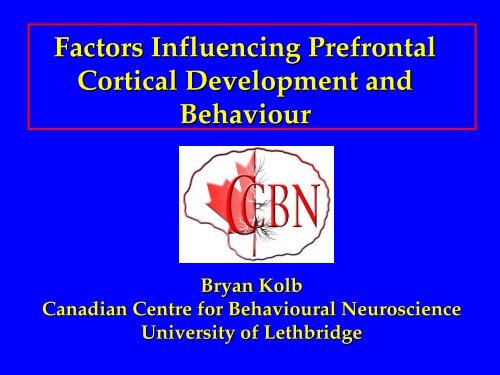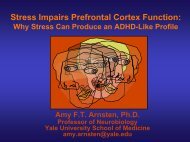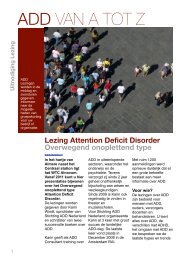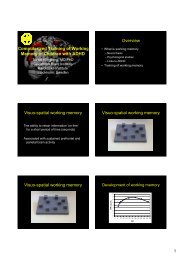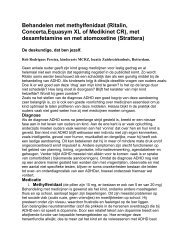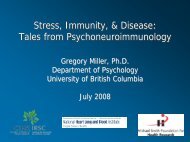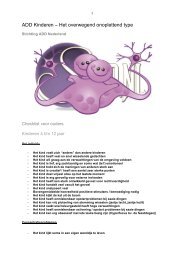Bryan Kolb: Factors influencing Prefrontal Cortical Development and ...
Bryan Kolb: Factors influencing Prefrontal Cortical Development and ...
Bryan Kolb: Factors influencing Prefrontal Cortical Development and ...
You also want an ePaper? Increase the reach of your titles
YUMPU automatically turns print PDFs into web optimized ePapers that Google loves.
<strong>Factors</strong> Influencing <strong>Prefrontal</strong><br />
<strong>Cortical</strong> <strong>Development</strong> <strong>and</strong><br />
Behaviour<br />
<strong>Bryan</strong> <strong>Kolb</strong><br />
Canadian Centre for Behavioural Neuroscience<br />
University of Lethbridge
SPECIAL THANKS TO<br />
WENDY COMEAU<br />
ROBBIN GIBB<br />
GRAZYNA GORNY<br />
CANADIAN INSTITUTE FOR ADVANCED RESEARCH<br />
NSERC<br />
CIHR
OBJECTIVES<br />
1. Underst<strong>and</strong> organization of PFC<br />
2. Underst<strong>and</strong> prolonged PFC development<br />
3. Consider factors altering PFC development<br />
4. Recognize the prolonged <strong>and</strong> profound effects<br />
of early experience on brain functioning…
What is the prefrontal cortex?<br />
1. There is a region in all mammals that lies in<br />
front of the motor cortex <strong>and</strong> has a unique<br />
set of connections with the rest of the brain.<br />
2. The PFC increases in parallel with increases<br />
in sensory representations of the external<br />
world.<br />
3. There are multiple PFC regions.
What is the PFC?
How does the PFC do its job?<br />
Sensory input is to the brain is divided<br />
for object recognition <strong>and</strong> motor control.<br />
Conscious vs<br />
unconscious<br />
Past vs present
How does the PFC do its job?<br />
The prefrontal cortex combines the 2<br />
systems.<br />
Place <strong>and</strong> time<br />
Internal & external<br />
Past, present, future
How do we define PFC?<br />
1. Connections with dorsal medial<br />
nucleus of thalamus.<br />
2. Connections with amygdala.<br />
3. Dopamine input from VTA<br />
4. Other connetions
Rhesus Monkey<br />
Stipple area: MD projection field<br />
Gray area: Amygdala projection field<br />
DA projection similar to MD field
Is the human PFC special?<br />
The key difference between different mammalian<br />
species is the complexity <strong>and</strong> nature of the sensory<br />
representations of the world.<br />
The human brain has the most complex<br />
representation, in part related to language, <strong>and</strong><br />
thus the largest volume of PFC.<br />
Von Economo cells may be unique…
What does the PFC do?<br />
Temporal organization of behaviour:<br />
-ongoing record of sensory exp<br />
=working memory
What does the PFC do?<br />
Temporal organization of behaviour:<br />
-ongoing record of sensory exp<br />
-ongoing record of reafference<br />
=the importance of corollary discharge<br />
=ANS monitoring
What does the PFC do?<br />
Temporal organization of behaviour:<br />
-ongoing record of sensory exp<br />
-ongoing record of reafference<br />
-sensory selection<br />
=attention
What does the PFC do?<br />
Temporal organization of behaviour:<br />
-ongoing record of sensory exp<br />
-ongoing record of reafference<br />
-sensory selection<br />
-inhibition of competing impulses<br />
=organization of behavior
What does the PFC do?<br />
Temporal organization of behaviour:<br />
-ongoing record of sensory exp<br />
-ongoing record of reafference<br />
-sensory selection (attention)<br />
-inhibition of competing impulses<br />
-flexible to changing contexts<br />
=social behaviour; ; spontaneity;<br />
Some forms of learning
=role of reward- exogenous & endogenous<br />
What does the PFC do?<br />
Temporal organization of behaviour:<br />
-ongoing record of sensory exp<br />
-ongoing record of reafference<br />
-sensory selection (attention)<br />
-inhibition of competing impulses<br />
-flexible to changing contexts<br />
-monitoring of consequences
Examples of deficits of<br />
temporal control:<br />
Abnormal social & sexual behaviour<br />
Disorganization in planning, esp<br />
related to ordering behaviours<br />
Short-term term memory<br />
Loss of reward<br />
Loss of spontaneity<br />
Loss of autobiographical memory
What does this have to do<br />
with anything?<br />
1. <strong>Factors</strong> that alter PFC will fundamentally<br />
alter nearly all behaviour.<br />
2. Hebb’s (1949) premise:<br />
The PFC plays a fundamental role in<br />
the development of cognitive schemata.<br />
Thus, the PFC is more important in<br />
development than in adulthood.
Key Points<br />
1. The emergence of PFC processes<br />
is profoundly influenced by<br />
experience…<br />
2. <strong>Prefrontal</strong> development is<br />
prolonged until at least 20 yrs
But, not<br />
done until<br />
at least age<br />
20 years…
Correlation between brain growth <strong>and</strong> reduced<br />
gray matter density: RED means the biggest changes
Total Volume<br />
Gray Volume<br />
White Volume<br />
Ventricle Volume
<strong>Development</strong>al Surprises<br />
1. The OFC matures faster than the mPFC.<br />
2. The OFC matures faster in females than<br />
males (Bachevalier monkey studies)<br />
3. Effects of early PFC injury are different in<br />
mPFC <strong>and</strong> OFC <strong>and</strong> sexually dimorphic.
Measuring brain-behaviour<br />
behaviour<br />
relationships<br />
Functions of the brain can be inferred<br />
at many levels from behaviour to structure.<br />
I will focus on these two.
The <strong>Cortical</strong> Neuron<br />
Brain Plasticity:<br />
1. Pruning during<br />
development.<br />
2. Changing the<br />
wiring diagram…
A frontal lobe pyramidal<br />
neuron<br />
Synapse number can be estimated<br />
by knowing the length of the<br />
dendritic fields <strong>and</strong> the spine density.<br />
One key feature is that both measures<br />
can go up or down with experience -<br />
thus reflecting an increase or decrease in<br />
synapse number.<br />
These changes have implications for<br />
behavioural change..
Arnold Scheibel’s Story<br />
Cell Structure<br />
1. Complexity of<br />
computations<br />
2. Education<br />
3. Sex effect
Thus…<br />
When the brain changes, this is<br />
reflected in behavioural change.<br />
This change is known by names such<br />
as learning, memory, addiction,<br />
maturation, ageing, recovery,<br />
psychopathology, etc.
The principles of brain organization<br />
<strong>and</strong> development are similar for all<br />
mammals
<strong>Factors</strong> altering PFC development<br />
The developing PFC is altered by many<br />
pre- <strong>and</strong> postnatal events including:<br />
1. gonadal hormones<br />
2. stress<br />
3. Sensory <strong>and</strong> motor experience<br />
4. psychoactive drugs (e.g., nicotine, caffeine,<br />
antidepressants, <strong>and</strong> more…)<br />
5. Social relationships, including play<br />
6. Cognitive experience
Differences in<br />
<strong>Cortical</strong> plasticity
Hormones change more than genitals…
Gonadal hormones change more than the<br />
Genitals…<br />
Relative volume of cortical regions in women <strong>and</strong> men<br />
This means that females <strong>and</strong> males should behave differently!
Gonadal hormones have organizing effects on PFC<br />
<strong>Kolb</strong> & Stewart, 1991,<br />
J. Neuroendocrinology<br />
Males have more synapses<br />
in MF<br />
Females have more synapses<br />
in OF<br />
The effects are hormone-<br />
dependent.
<strong>Factors</strong> altering PFC development<br />
The developing PFC is altered by many<br />
Pre- <strong>and</strong> postnatal events including:<br />
1. gonadal hormones<br />
2. stress<br />
3. Sensory <strong>and</strong> motor experience<br />
4. psychoactive drugs (e.g., nicotine, caffeine,<br />
antidepressants, <strong>and</strong> more…)<br />
5. Social relationships, including play<br />
6. Cognitive experience
Early Experience alters stress axis<br />
Acute, mild<br />
stress<br />
Chronic stress<br />
OR high stress<br />
<strong>Development</strong> of<br />
Stress Reactivity<br />
Modest Stress<br />
Reactivity<br />
Reduced Risk for<br />
Disease<br />
Increased Stress<br />
Reactivity<br />
Increased Risk for Heart<br />
Disease, Type II Diabetes,<br />
Alcoholism, Affective Disorders,<br />
Brain Aging etc.
Adult Stress<br />
Altered PFC organization<br />
more synapses in OFC<br />
fewer in mPFC<br />
no change in other ctx<br />
regions<br />
Liston et al., J Neuroscience,<br />
2006
Prenatal Stress<br />
1. Smaller brains<br />
2. Altered PFC<br />
development<br />
fewer synapses in OFC<br />
fewer in mPFC<br />
no change in other regions<br />
Halliwell, Gibb & <strong>Kolb</strong>, in progress
So what?<br />
The changed structure of the PFC regions<br />
means that they will function differently…<br />
AND that they will respond to other<br />
experiences differently
Turning Gold into Lead<br />
The ACE (Adverse Childhood Experiences) Study.<br />
17,000+ middle-aged adults in USA<br />
Findings:<br />
1. ACEs are more common than recognized<br />
2. ACEs have a powerful relation to adult health<br />
50 yrs later.
Turning Gold into Lead<br />
Examples of ACEs:<br />
-family violence: spousal or child related<br />
-parental alcohol or drug addictions<br />
-sexual abuse<br />
-growing up in a household where someone is in jail<br />
-parental chronic depression or other ‘mental’ illness<br />
-loss of one parent for whatever reason
Outcomes after age 55<br />
1. 50% experienced at least one ACE <strong>and</strong> 25% had 2 ACEs<br />
6% had 4 ACEs<br />
MANY conditions are related to ACEs<br />
-smoking or other addictions<br />
-heart <strong>and</strong> lung disease<br />
-depression<br />
-diabetes<br />
-hypertension<br />
-macular degeneration<br />
-psoriasis<br />
-suicide (or attempted)<br />
-etc<br />
The increase in incidence varies from about 3X for smoking to<br />
50X for drug addiction <strong>and</strong> 50X for attempted suicide with 2+
Why?<br />
For at least some of the outcomes, it is<br />
Likely that there are changes in PFC <strong>and</strong> HPC<br />
that lead to bad decisions.<br />
Example, 5X increase in risk of sexual assault
A “Natural” Experiment:<br />
Romanian Orphans Adopted in UK, Canada,<br />
& USA
Romanian Communist<br />
Policy:1966 decree<br />
Raise productivity by increasing population<br />
Establishment of the MENSTRUAL POLICE - state<br />
gynecologists who conducted monthly checks of women of<br />
childbearing age who had not borne at least 5 children<br />
OUTLAWED all contraception <strong>and</strong> abortion<br />
RESULT: A national disaster.<br />
Parents could not afford to raise the children.<br />
Thous<strong>and</strong>s of children were turned over to the state<br />
to be raised in institutions.
A “Natural” Experiment:<br />
Romanian Orphans Adopted<br />
Children adopted after 6-12 mo of age show at 11 years:<br />
1. Abnormal brain development (e.g., small brain, low<br />
metabolic activity, abnormal EEG)<br />
2. Social <strong>and</strong> cognitive problems (e.g., IQ loss)<br />
3. High vulnerability to behavioural problems<br />
(e.g., ADHD, aggression)
<strong>Factors</strong> altering PFC development<br />
The developing PFC is altered by many<br />
Pre- <strong>and</strong> postnatal events including:<br />
1. gonadal hormones<br />
2. stress<br />
3. Sensory <strong>and</strong> motor experience<br />
4. psychoactive drugs (e.g., nicotine, caffeine,<br />
antidepressants, <strong>and</strong> more…)<br />
5. Social relationships, including play<br />
6. Cognitive experience
Shaping Brain <strong>Development</strong><br />
Complex Housing<br />
Postnatal<br />
Prenatal (even dads…)<br />
Brains are larger,<br />
have more connections<br />
The animals have<br />
enhanced cognitive<br />
<strong>and</strong> motor behaviour
Getting to the brain<br />
via the skin<br />
Postnatal Infant<br />
Prenatal<br />
Also can use a broad spectrum light…
What is the effect of the tactile stimulation?<br />
-Larger brain<br />
-More connections generally in cortex<br />
-Enhanced cognitive & motor performance<br />
-Changes in the genes turned ‘on’ <strong>and</strong> ‘off’<br />
(epigenetic changes)<br />
Conclusion: Experience can alter the production<br />
of proteins in the skin, which in turn<br />
can alter the PFC through effects on genes.
How does this work?<br />
Skin <strong>and</strong> brain are developmentally<br />
related <strong>and</strong> respond to the same<br />
factors such as<br />
FGF-2
And the point is?<br />
Think about parent-infant<br />
interactions.<br />
We return to this…
Does experience have the same effects<br />
at different times in life?<br />
NO!<br />
There are qualitative differences at<br />
different stages of life.<br />
There is something fundamentally<br />
different prenatally vs infancy vs<br />
juvenile vs adult<br />
One difference is gene expression…
Complex housing increases dendritic length at all ages<br />
Complex housing<br />
Par<br />
increases<br />
1 Dendritic Length<br />
dendritic length at all ages<br />
Mean Total Grid Crossings<br />
130<br />
120<br />
110<br />
100<br />
90<br />
80<br />
Lab<br />
Condo<br />
70<br />
60<br />
50<br />
40<br />
Young Adult Old
Complex housing alters spine density differently in young rats<br />
Complex housing Par alters 1 Terminal spine Tip Apical density Spinesdifferently in young rats<br />
7<br />
Lab<br />
Condo<br />
Mean Spines per 10 μm<br />
6<br />
5<br />
4<br />
3<br />
2<br />
Young Adult Old
Break Time?
<strong>Factors</strong> altering PFC development<br />
The developing PFC is altered by many<br />
Pre- <strong>and</strong> postnatal events including:<br />
1. gonadal hormones<br />
2. stress<br />
3. Sensory <strong>and</strong> motor experience<br />
4. . Psychoactive drugs<br />
5. Social relationships, including play<br />
6. Cognitive experience
Drug-induced behavioural sensitization<br />
The phenomenon whereby<br />
there is an escalating behavioral response to<br />
repeated administration of a constant dose of a<br />
psychomotor stimulant such as amphetamine,<br />
cocaine, or nicotine.
Similar Results are seen in mPFC but not<br />
in sensory or motor areas<br />
Similar results are seen with cocaine & nicotine.<br />
Caffeine produces somewhat different changes
BUT…<br />
The<br />
effects are exactly opposite in OFC!
Thus,<br />
Psychoactive drugs are chronically altering the<br />
the PFC <strong>and</strong> are changing the PFC in an<br />
areal-dependent manner.<br />
This must be important in underst<strong>and</strong>ing PFC<br />
function <strong>and</strong> dysfunction.<br />
Recall that hormones also have different effects<br />
on n the two regions…
The drug-induced changes are not trivial:<br />
NAcc = 37% increase in total synapses per neuron<br />
PFC = 19% increase in total synapses per pyramidal neuron<br />
OFC = 20% decrease in total synapses per pyramidal neuron
Is this just about stimulants?<br />
NO!!<br />
Morphine<br />
THC<br />
PCP<br />
Fluoxetine (prozac)<br />
Valium<br />
Antipsychotics<br />
But the pattern of changes is drug-unique.<br />
unique.
What about development?<br />
Ritalin <strong>and</strong> amphetamine produce the same<br />
changes in the developing brain EXCEPT there<br />
are NO changes in N.Acc, , just the PFC. This is<br />
like THC in adults.<br />
Experience interacts with the drug effects<br />
differently in young <strong>and</strong> mature animals.
Are there long-term consequences?<br />
1. Pathology of brain <strong>and</strong> behaviour.
There is a pathological<br />
appearance to PFC neurons<br />
in rats that self-administer<br />
cocaine.<br />
Such animals show behavioural<br />
impairments on PFC-related<br />
behavioural tasks.
How might the changes be related to the<br />
maladaptive behaviour of addicts?<br />
1. The pathology in PFC function may<br />
suggest that addicts fail to have insight<br />
into their behavior because of abnormal<br />
PFC functioning.<br />
2. The changes in orbital cortex would be<br />
consistent with poor social judgements &<br />
loss of inhibition.
Are there long-term consequences?<br />
1. Pathology of brain <strong>and</strong> behaviour.<br />
2. Both ritalin <strong>and</strong> amphetamine as juveniles<br />
produce deficits in learning of PFC-related<br />
tasks in adulthood.<br />
(But the rats are not ADHD.)
Drugs <strong>and</strong> later experience<br />
Drug Treatment + = ?<br />
OR does experience alter the effects of drugs<br />
OR do the two interact given simultaneously
Are there long-term consequences?<br />
1. Pathology of brain <strong>and</strong> behaviour.<br />
2. Both ritalin <strong>and</strong> amphetamine as juveniles<br />
produce deficits in learning of PFC-related<br />
tasks in adulthood.<br />
3. Amphetamine, cocaine & nicotine block later<br />
experience-dependent plasticity in adulthood<br />
<strong>and</strong> development.<br />
(REMEMBER: age-related differences)
What about prenatal effects?<br />
According to NIDA,<br />
25% of pregnant moms smoke<br />
10% of pregnant moms drink alcohol<br />
Close 100% of pregnant moms consume caffeine
Drug Effects in Developing Brain<br />
1. Ritalin: mPFC hypertrophy; abnormal<br />
play; abnormal cognition<br />
2. Prenatal Fluoxetine (Prozac):<br />
generalized atrophy of cortical<br />
neurons<br />
3. Antipsychotics: Specific atrophy<br />
of PFC & NAcc neurons<br />
Remember: these rats were “normal”
<strong>Factors</strong> altering PFC development<br />
The developing PFC is altered by many<br />
Pre- <strong>and</strong> postnatal events including:<br />
1. gonadal hormones<br />
2. stress<br />
3. Sensory <strong>and</strong> motor experience<br />
4. psychoactive drugs (e.g., nicotine, caffeine,<br />
antidepressants, <strong>and</strong> more…)<br />
5. Social relationships<br />
6. Cognitive experience
Social Relationships<br />
1. Play partners<br />
2. Parent-infant interactions
All mammals have play<br />
behaviour with rules
Little Play: Adult + Juvenile<br />
Enriched Play: 4 Juveniles<br />
Bell, Pellis & <strong>Kolb</strong>, in progress<br />
Limited Play: 2 Juveniles
Sibling play = more complex OFC<br />
Adult “play” = more complex mPFC
<strong>Factors</strong> <strong>influencing</strong> play behavior<br />
1. Play partners<br />
2. OFC injury= failure to underst<strong>and</strong> rules<br />
3. Stress= reduce play initiation<br />
4. Drugs= e.g., Ritalin effects similar to<br />
PFC injury.<br />
Conclusion:<br />
Play fundamentally alters brain<br />
development.<br />
Anything that changes play will alter brain<br />
development - <strong>and</strong> other behaviours.
Parents change us too…<br />
All mammals show a large within-species<br />
range in contact time…
Social Relationships<br />
There is about a 6 hr difference at the ends of<br />
the continuum of parent-infant contact.<br />
Our working hypothesis is that this alters PFC<br />
development via the effects of contact.
<strong>Factors</strong> altering PFC development<br />
The developing PFC is altered by many<br />
Pre- <strong>and</strong> postnatal events including:<br />
1. gonadal hormones<br />
2. stress<br />
3. Sensory <strong>and</strong> motor experience<br />
4. psychoactive drugs (e.g., nicotine, caffeine,<br />
antidepressants, <strong>and</strong> more…)<br />
5. Social relationships, including play<br />
6. Cognitive experience
Early learning alters PFC<br />
development<br />
Example: Train juveniles on PFC-<br />
Dependent tasks = increased synapses in<br />
mPFC <strong>and</strong> OFC.
What about other developmental<br />
Disorders?<br />
1. Schizophrenia<br />
Weinberger model: transient hippocampal perturbation<br />
-PFC related behavioural abnormality<br />
-mPFC cell atrophy<br />
-OFC hypertrophy<br />
-NAcc atrophy
Schizophrenia Model<br />
Weinberger/Lipska model<br />
-neonatal HPC perturbations<br />
-mPFC-like abnormalities in behaviour<br />
-PET shows drop in activation in DL PFC<br />
Dendrites?<br />
mPFC & N.Acc. Atrophy<br />
OFC hypertrophy
What about other developmental<br />
Disorders?<br />
2. Genetic predispositions
Fast VS Slow Kindlers<br />
FAST (kindling prone) rats act like juvenile<br />
rats indefinitely.<br />
e.g., play behaviour, activity, impulsivity,<br />
reduced fear<br />
SLOW rats act like mature rats even as juveniles.
FAST vs SLOW<br />
Although there Are<br />
no differences in<br />
sensory or motor areas, there was a clear<br />
mPFC vs OFC difference.<br />
mPFC: : FAST>SLOW<br />
OFC: SLOW>FAST<br />
Relationship to juvenile behaviour of the FAST?<br />
Note that the pattern is like the sex difference…<br />
Note that the pattern is like psychomotor stims
Conclusions<br />
1. The PFC is fundamental to the<br />
organization of complex behaviours.<br />
2. PFC development is prolonged.<br />
3. PFC development is profoundly<br />
altered by a wide range of experiences<br />
4. Changes in PFC development plays a<br />
key role in underst<strong>and</strong>ing both<br />
normal & abnormal behaviour.


